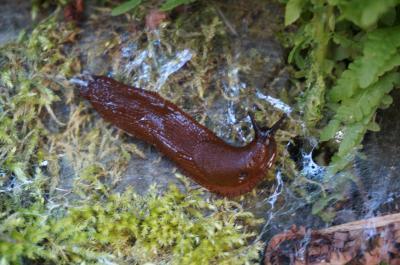Frankfurt am Main, Germany, June 18th 2014. Spanish slugs (Arion lusitanicus) are one of the most common slug species in Central Europe. The animals sometimes nicknamed "killer slugs" are known to do their fair share of damage in fields and gardens. The slug was thought to have originated in Southern Europe. However researchers of the German Biodiversity and Climate Centre and the Goethe University now found out, that the prime example of an invasive species is originally from Central Europe and thus no "immigrant" after all. Control measures, such as the EU regulation on prevention, early warning, rapid response, and management of invasive species which is being discussed currently, would therefore not apply to this species. Spanish slugs (Arion lusitanicus) are one of the most common slug species in Central Europe. The animals sometimes nicknamed "killer slugs" are known to do their fair share of damage in fields and gardens. The slug was thought to have originated in Southern Europe. However researchers of the German Biodiversity and Climate Centre and the Goethe University now found out, that the prime example of an invasive species is originally from Central Europe and thus no "immigrant" after all. Control measures, such as the EU regulation on prevention, early warning, rapid response, and management of invasive species which is being discussed currently, would therefore not apply to this species.
For some time conservationists have made aware of the fact that the rapidly growing number of brown Spanish slugs is replacing the native black slug in Central Europe as well as inflicting significant damage on natural vegetation and agricultural products. The numbers speak for themselves: today Arion lusitanicus is the most common species of snail in Germany. It is also ranked among the "100 of the worst" invasive animal and plant species in Central Europe that are thought to have a significant negative impact on biodiversity, economy and health. Allegedly the Spanish Slug made its way to Central Europe with imports of fruit and vegetables in the 1950s.
No Spanish slugs to be found in Spain
When taking stock German researchers however could not find a single individual of the slug in its presumed home country. In the spring of 2010 researchers of the Biodiversity and Climate Research Centre and the Goethe University collected 300 specimens of the snail in 60 locations in France, Spain, the UK and the Benelux countries and identified the species they came from. "Instead of the Spanish slug we found numerous, so-called cryptic species, which are indistinguishable using traditional methods of taxonomy which is based on morphology. Therefore, the animals were identified using DNA sequence data" lead author Prof. Markus Pfenninger, who conducts research on BiK-F and the Goethe University and teaches, explains.

This is a specimen of the Spanish slug Arion lusitanicus.
(Photo Credit: M. Pfenninger)
Many cryptic species
Many of the specimens examined did not fit to a previously described, genetically characterized species. "We found a lot of unnamed, sometimes highly divergent haplotypes. This indicates the presence of several undescribed Arion species which we only discover using DNA taxonomy. It follows that Arion is very unresolved genus from a taxonomic point of view." But looking into the genes of the slugs yielded even more insights. Shared mutations in the genetic information of different individuals indicate relationships between them. "On the basis of this we created a phylogenetic tree and related it to the geographic distribution. It showed why we could not find Arion lusitanicus in its alleged homeland. The species is definitely not native to Spain but originated in Central Europe" concludes Pfenninger.
EU-regulations on alien species would not necessarily apply
According to experts there are more than 12,000 non-native species in Europe, and the number is increasing. Alien species are one of the main threats to biodiversity and native species as well as causing immense economic damage, e.g. via yield losses in agriculture. In April 2014 the EU parliament therefore approved a proposal for EU-wide measures to ban further import of non-native species and combatting non-native species which are already at home in EU more effectively. "Whether a species is classified as native or not will influence its management policy. Our research goes to show that we should be more prudent in labeling a species 'invasive' or non-native when the evidence for anthropogenic introduction is poor", says Pfenninger and adds: "Perhaps the rapid increase in Spanish slugs we have seen in the last decades is caused by changes of land use practice. It may seem like an invasion when in truth there isn't one going on ".
Source: Goethe University Frankfurt